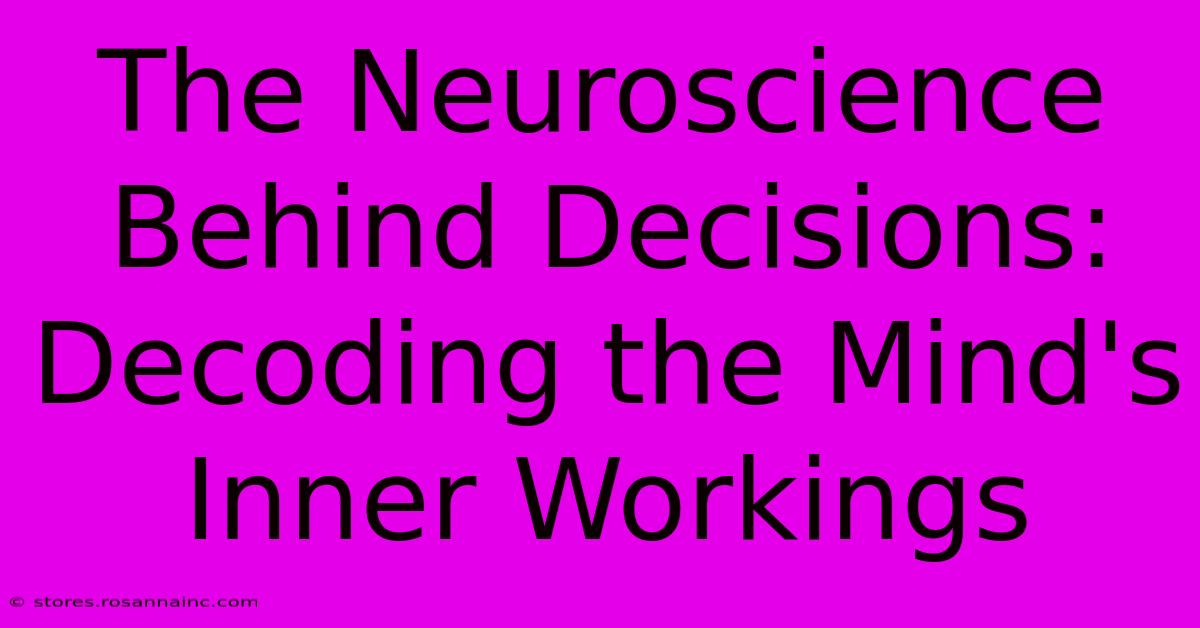The Neuroscience Behind Decisions: Decoding The Mind's Inner Workings

Table of Contents
The Neuroscience Behind Decisions: Decoding the Mind's Inner Workings
Our daily lives are a tapestry woven from countless decisions, from the seemingly trivial—what to eat for breakfast—to the profoundly consequential—choosing a career path. But what's actually happening inside our brains when we make these choices? Understanding the neuroscience behind decisions reveals a fascinating interplay of brain regions, neurochemicals, and cognitive processes. This exploration delves into the complex mechanisms that govern our choices, highlighting the intricate dance between logic and emotion in shaping our actions.
The Key Players: Brain Regions Involved in Decision-Making
Several brain regions collaborate in the intricate process of decision-making. No single area holds the reins; instead, a sophisticated network orchestrates our choices:
1. The Prefrontal Cortex (PFC): The Executive Control Center
The PFC, located at the front of the brain, acts as the executive control center for decision-making. It's crucial for:
- Planning and Goal Setting: The PFC helps us define our objectives and strategize how to achieve them.
- Working Memory: It holds information relevant to the decision at hand, allowing us to weigh options and consider consequences.
- Inhibition: The PFC helps suppress impulsive behaviors and consider long-term implications before acting.
- Cognitive Flexibility: It enables us to shift between different strategies and adapt to changing circumstances.
2. The Amygdala: The Emotional Compass
The amygdala, a small almond-shaped structure deep within the brain, plays a vital role in processing emotions, particularly fear and reward. It influences decisions by:
- Assessing Risk and Reward: The amygdala rapidly evaluates potential threats and rewards, biasing our choices towards safety or pleasure.
- Emotional Biases: Strong emotions can override rational thought, leading to impulsive decisions driven by fear or excitement.
3. The Nucleus Accumbens: The Reward Center
The nucleus accumbens is a key component of the brain's reward system. It releases dopamine, a neurotransmitter associated with pleasure and motivation. This region influences decisions by:
- Reinforcement Learning: Positive experiences strengthen neural pathways, making similar choices more likely in the future.
- Motivation and Drive: The anticipation of reward fuels our decision-making process, driving us to pursue goals and make choices that promise gratification.
4. The Anterior Cingulate Cortex (ACC): The Conflict Monitor
The ACC detects conflicts between different options or between our desires and our goals. It plays a critical role in:
- Error Detection: The ACC identifies when a decision has led to a negative outcome, prompting adjustments in future choices.
- Conflict Resolution: It helps us resolve conflicting impulses and make choices that align with our overall goals.
Neurochemicals Shaping Our Choices
Neurochemicals profoundly influence decision-making. The delicate balance of these substances significantly impacts our choices:
1. Dopamine: The Reward Signal
Dopamine is released when we experience pleasure or anticipate a reward. It reinforces behaviors associated with positive outcomes, shaping our preferences and future choices.
2. Serotonin: The Mood Regulator
Serotonin influences mood, impulse control, and emotional regulation. Low serotonin levels are associated with impulsive decision-making and increased risk-taking.
3. Norepinephrine: The Alertness Booster
Norepinephrine enhances alertness and attention, influencing how we process information and make decisions under pressure.
Factors Influencing Decision-Making: Beyond the Brain
While brain regions and neurochemicals are crucial, other factors significantly influence our decisions:
- Cognitive Biases: Systematic errors in thinking can distort our judgment and lead to suboptimal choices. Examples include confirmation bias (favoring information confirming existing beliefs) and anchoring bias (over-relying on the first piece of information received).
- Social Context: Our social environment, including peer pressure and cultural norms, profoundly impacts our decisions.
- Past Experiences: Previous successes and failures shape our expectations and influence future choices.
Conclusion: A Complex Interplay
Understanding the neuroscience behind decisions reveals a complex interplay of brain regions, neurochemicals, and cognitive processes. While our brains strive for rationality, emotions, biases, and external influences significantly shape our choices. By unraveling the intricacies of this process, we can gain valuable insights into human behavior and develop strategies for making more informed and effective decisions. Further research into this fascinating field holds the key to improving our decision-making capabilities and enhancing our overall well-being.

Thank you for visiting our website wich cover about The Neuroscience Behind Decisions: Decoding The Mind's Inner Workings. We hope the information provided has been useful to you. Feel free to contact us if you have any questions or need further assistance. See you next time and dont miss to bookmark.
Featured Posts
-
Unleash Your Chemical Genius Join Our Team And Shape The Future Of Innovation
Feb 05, 2025
-
Productivity Hack Master The Art Of Converting Word Docs To Google Docs
Feb 05, 2025
-
The Con Games Unmasked Top 10 Misleading Ads You Need To Avoid
Feb 05, 2025
-
Dont Miss Out Limited Time Offer On Perry Homes Santa Rita Ranch Properties
Feb 05, 2025
-
Lions Vs Saints The Clash Of Titans That Will Shake The Gridiron
Feb 05, 2025
